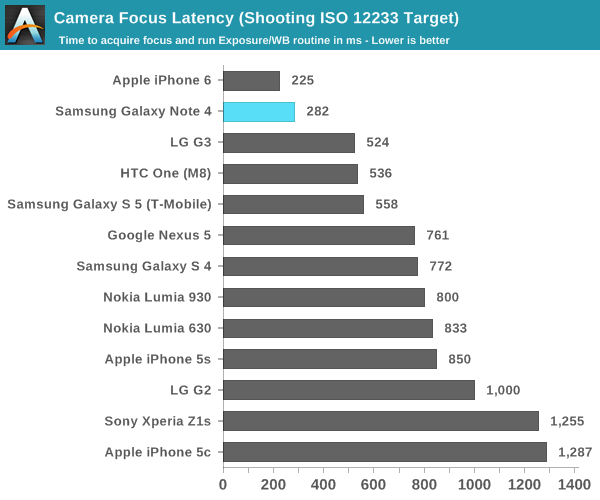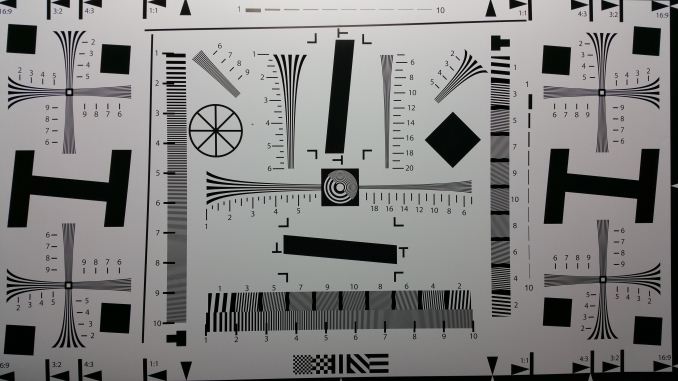The Samsung Galaxy Note 4 Review
by Joshua Ho on October 15, 2014 9:00 AM EST- Posted in
- Smartphones
- Samsung
- Android
- Mobile
- Galaxy Note 4
Camera
While the 16MP camera of the Galaxy Note 4 is mostly what we would expect, Samsung has really changed things up with the addition of OIS. Outside of this addition and the Sony IMX240 sensor, there’s really not a lot of change when it comes to the Galaxy Note 4. This means that we see the same 31mm equivalent focal length and F/2.27 aperture. At this point, it seems that OIS has finally reached mainstream adoption as both Samsung and Apple are shipping OIS solutions on their phones. The front facing camera is noticeably different though, with a Samsung S5K6D1YX sensor that I haven't seen elsewhere.
However, before we get into the proper image quality analysis I wanted to first cover shot to shot latency and focus/AE latency, as both are critical to a good image capture experience. Even if it’s possible to get amazing photos from a camera, it doesn’t really matter if the moment is missed. In order to test this, we look at the ideal case, which is when the phone is pointed at the ISO chart with bright lighting to maximize contrast.


As one can see in the graphs above, capture latency and focus latency are quite competitive with on the Note 4. However, there is one crucial detail that the focus latency graph misses, which is that Samsung doesn’t have continuous auto-focus in preview with the Note 4. As a result, there’s realistically an additional latency period before the auto-focus begins to run. The result is that the total time from out of focus to in focus is realistically closer to 800ms, but if one immediately taps the display to begin an AF run it’s possible to achieve the lower bound value, which is just south of 300ms.
Still Image Performance
While I'm still working on moving towards a better test for cameras, for now we have our standard photo comparisons that should give a good idea of what to expect from a smartphone camera in comparison to other cameras. Our first test is the standard ISO chart, which allows for a good test of maximum resolution.

For this first test, it seems that Samsung hasn't really changed much when it comes to maximum resolution, and in general the Note 4 produces similar output to the Galaxy S5. To verify this and a test of dynamic range, we'll look at a landscape shot next.
In this test, we see that the Galaxy Note 4 generally does well with detail and dynamic range as the landscape is generally well-detailed, although there's quite a bit of detail that seems to be smudged away on the grass as it seems to be a flat green texture for the most part. There's also noticeable color artifacting on the bleachers in the distance. We'll look at the same scene in low light to get a better idea for what the Note 4 really brings to the table.
Here, in low light we see significant improvements in image quality when comparing the Galaxy S5 to the Galaxy Note 4. The iPhone 6 Plus and Note 4 are quite close in overal quality, but looking at the brick building on the right of the image shows that the iPhone 6 Plus is maintaining a higher level of detail in this scene.
In the case of HDR, Samsung continues to do a great job with their implementation. For the most part this feature is successfully implemented with no real halos or other artifacts even when there are moving objects in the shot. This is likely to be implemented through on-sensor HDR rather than image combination.





































195 Comments
View All Comments
Donkey2008 - Wednesday, October 29, 2014 - link
You have to love the 3DMark "onscreen" vs "offscreen" results. As long as any Android doesn't have to actually render images on the screen for the user than it is just as fast as an iPhone. ROLMAO.Announcer97624 - Saturday, November 1, 2014 - link
I don't get the point about battery life trailing behind the IPhone 6 plus? The IPhone 6 plus doesn't have a removable battery so on a 16 hour plane ride the IPhone 6 plus is a liability not an asset compared to the Galaxy Note 4's ability to have a few spare charged batteries. While I have the European Galaxy S5 4G LTE I have a battery wallet with six fresh batteries so I can go for most of a week without charging. My girlfriend has an IPhone 5 and is now going to purchase the Galaxy Note 4 specifically because of the non removable battery on all IPhones.Bikerboy89 - Saturday, November 8, 2014 - link
Wow onscreen GPU performance is laughable. Really bad vs the competition from apple and Nvidia. My LG G Flex gets better onscreen performance in gfxbench and the iPhone 6 gets double or triple Note 4. Pretty pathetic for a flagship device.MattL - Wednesday, November 19, 2014 - link
I finally realize why your color accuracy results differ so much from display mate, where you find the iPhone is more color accurate they found the Note 4 more accurate.http://www.displaymate.com/news.html#Color_Accurac...
"Recently some reviewers have published articles contradicting my Absolute Color Accuracy Measurements for the Samsung Galaxy S5. For example, see this recent review in phone Arena. The problem is that these reviewers are not scientists or display experts, and are using canned display calibration software incorrectly in order to test a display, which produces incorrect results and bogus conclusions. Below is a brief semi-technical analysis...
The Color Difference dE used by the Reviewers Incorrectly includes the Luminance: The reviewers are using retail display calibration software products that use a Color Difference measure called dE, which includes a Luminance (Brightness) Error component in addition to the Color Hue and Saturation (Chromaticity) Error component. Using the Color Difference dE is appropriate for setting the display calibration, but dE is Not a measure of Visual Color Accuracy (Hue and Saturation) because it also includes the Luminance (Brightness). The eye sees and interprets brightness and color as two separate visual issues - dE combines them together. So all conclusions based on using dE for Visual Color Accuracy are incorrect.
Our Color Accuracy only includes Color Hue and Saturation: Since the eye sees color and brightness as two separate visual issues I measure and analyze them separately. My published Absolute Color Accuracy measurements and data analysis includes only the Color (Hue and Saturation) Chromaticity Error component Δ(u'v') or d(u'v'), which evaluates just the difference in Hue and Saturation seen by the eye, and is plotted on a 1976 CIE Uniform Chromaticity Color Diagram in all of my articles. This is the correct method for evaluating Visual Color Accuracy (Hue and Saturation). Compare my very precise and detailed Absolute Color Accuracy plots with their crude figure."
Basically you're doing it wrong anandtech
kamhagh - Monday, May 25, 2015 - link
this phone lags on ui and on games like deadtrigger2, don't trust benchmarks! specially when its samsung..... benchamrks are only meaningless numbers!(well useful in some cases)